 The Multi Chine Proa
The Multi Chine Proa
The Difference between Theory and Reality
Sometimes the boat was finished, what means that we have had no idea what could be further done in theory. No the pracitical use must show what is missing - and exactly this happened.
But before the sailing story some hints for building:
You should use 1-2 stringer for every hull side, otherwise the 4 mm plywood makes visible cambers between the frames. The little weight more will be equalized by a better view and naturally more stability.
The surfmasts, we used for beams an mast were not stable enough. The will not break, bat they are to limberly at their positions. So the whole structure of the boat would to flexible, what had bad influence for rig and sail shape. A stiffening with carbon rovings makes it something better but for a future boat I would use alloy pipes with a diameter of 50 mm and 3 mm thickness.
But now at last on the way for launching. The transport on car top is absolutely easy. The beam rests fits optimally into the side to side braces of the car top carrier. In ten minutes the boat was fixed ready to go on the cars roof.
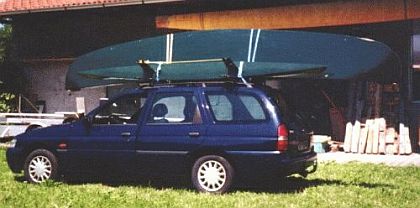
In the same way it last short time to fit it together ready for sail. For the first time we need only half an hour untill the boat was launched.
The First Trip
Actually it was I beautiful day, only the wind grows up with gust to force 5. But nevertheless today was the day! In the same fast manner we assemble the boat we are on the water - a little bit precipitately - but we would finally sail.
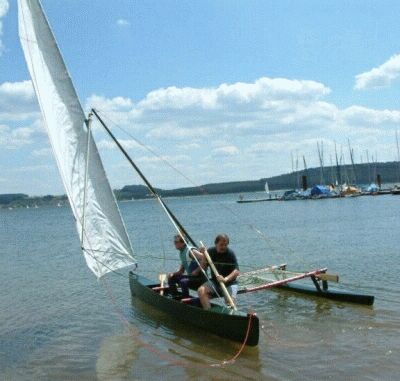
The first contact with its element. Here you see the large leeward bend of the mast made among others by the curve of the beams
However for us the providence had prepared something other. Leaded by a extreme luff tendency of the boat we made a big bow directly into the foot bridges of the near marina. Untill we had sorted all lines we are at land again. But without any fear we straighten the bow again to middle of the lake, and run away close hauled into the 'open sea'. In fact pretty accessful, because we sail very fast, although we both were 2/3 of the total displacement.
The steering with moving our bodies along our sitting plank to change the center of displacement was very hard because of the gusty wind and the boats luff tendency. The steering paddle seems to be without any effect. The result was that we get sometime a gust from the 'wrong' side an the rig cames down to the wrong side too. But because it was hold by rubber ropes nothing was damaged. The wind has in meantime reached permanent force 4 and we have had no chance to righten up the rig again. The way paddling home I don't need to describe ... we we used the time to talk about the 'Why'.
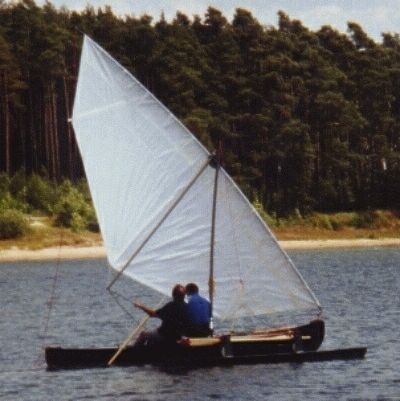
The yard is bend to much astern. But in principle the 50 $ sail looks good
The Experiences And The Redesign
Basically positiv was the general conception of all. The boat swims nearly at the thought cwl and carries finally two sailors with together about 150 kg (with a boat weight of nearly 75 kg). The asymmeric multi chine hull allows to sail close hauled with a acceptable leeway. The connection hulls-beams with a simple webbing proves strong enough. Also the polytarp sail was effective enough to give a good speed.Following two figures which show something about the 'accidents research'
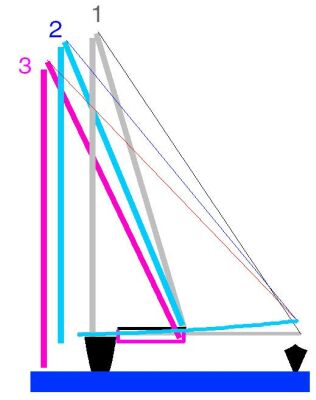
The figure shows the planned rig (1) and how the curve of the beams (2) and the sitting plank (3) effectuate the bend of the mast. Additionally a strech of the shroud reinforced this effect
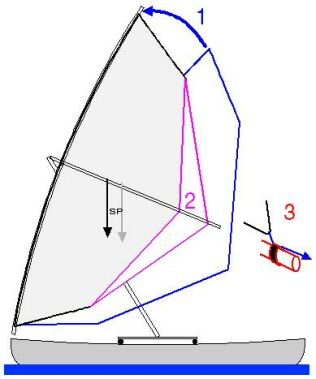
Moving of the CE by place the sail more upright (1) shortening the sail (2) and a control of the clew at the boom (3) should optimize the sail shape
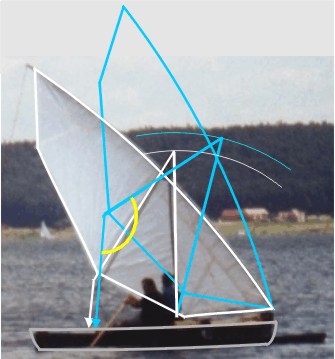
Problem after lenghten the mast. The sheeting angle become smaller and the deformation of the sail grows.
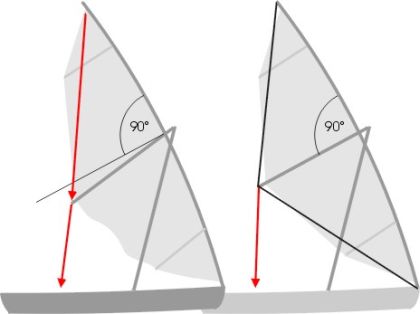
Solution by lines from the yard ends to the boom end, which should avoid to bring to much pull into the the sail. See also trim possibilities of the sail with the control lines.
Following changes are made before the next text:
- Stiffening of the beams and the mast via carbon rovings
- Stiffening of the sitting plank
- Lengthening of the mast by 50 cm to bring the CE nearer to the bow by arrange the yard more upright
- Clew control at the boom
- Doubling of the bungee stays to get the rigg stiffer
- Shortening of all lines to their necessary minimum for simpler handling and prevent to catch oneself ;-)
Second Test
Again a beautiful summerday at the Brombach reservoir for the second sailing test. Also the wind offers with a 2-3 force breeze best conditions. After an hour sailing we came back to our starting point indeed. In the time between we have had an eventfully trip. We tested the steering with moving the center of gravity and controlling the sail trim. It functions indeed. Moving to the bow means fall off, and moving astern means heading up. But all must be done with a lot of feeling and alert. The boat accelerates rapidly - you must immediate close in the sail - and in the same time move back with your body(s). The P5 is no boat for 'coffee sailors' (which means in German 'cushily'), you are continually claimed. If you are sailing with two aboard a permanent cooperation is need:'Go to front, go back, pull here, etc.' , especially during shunting maneuver.

After the first test run I risked a singlehand trip. Alone you are much more tranquil on the way, because you get very fast the right feeling for the boat and move automatically in the right direction. Also the speed increases naturally with less weight aboard and so I could sail the first meters with a flying ama. Of course shows this Bavarian lake that it is not the original home of a proa. Permanent turning and gusty wind are not useful conditions to sail such a boat in this way. As fast as it accelerates as fast it stopps again - and if in the meantime the wind turns - you get it from the wrong side. The only chance is now to turn the boat with you paddle too. BTW also as an atlantic proa the P5 runs surprisingly fast ;-). At last a word about the steering paddle. On all courses close to the wind you don't need it, it disturbs more as it helps. With moving the center of gravity you can steer untilt he wind cames beam reach. First at all courses with the wind broad reach till run you must use the paddle - and then it works.


Resume
The P5 is a basically well-tried boat. It's a fun machine for sailors which need an alternative to 'boring' beach catamarans. With a better sail shape and may be a better sail cloth I believe the P5 sould sail as fast as a comparably beach catamaran like eg. a Hobie 14. And if not, I promise you will sail it in minimum with the double of joy.Othmar Karschulin/Phil Young
 Building of the P5
Building of the P5 Additional thoughts to the used GD rig (Gibbons/Dierking)
Additional thoughts to the used GD rig (Gibbons/Dierking)
